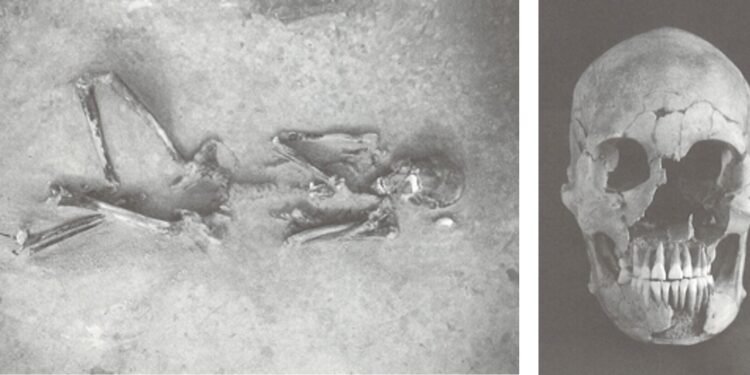Human remains from the Yayoi period, around 2,300 years ago, from which DNA has been extracted. Credit: Kim et al 2024
A joint research group led by Jonghyun Kim and Jun Ohashi of the University of Tokyo demonstrated that the majority of immigration to the Japanese archipelago during the Yayoi and Kofun periods (between 3000 BCE and 538 CE ) came from the Korean peninsula.
Researchers analyzed the complete genome of a “Yayoi” individual and found that among non-Japanese populations, the results had the most similarities to those of Korean populations. Although it is widely believed that modern Japanese populations have dual ancestry, the discovery provides insight into details of immigration patterns to the archipelago that have until now eluded scientists.
The results were published in the Journal of Human Genetics.
Today, Japan is an international hub for both business and pleasure. However, this was not always the case. The Japanese archipelago was relatively isolated during the Jomon period until around 3000 BCE. Then, during the Yayoi and Kofun periods, immigration to the islands from mainland Asia began.
“Ancestries related to East Asia and Northeast Asia account for more than 80% of the nuclear genomes of the modern Japanese population,” says Ohashi, the study’s lead researcher. “However, how the Japanese population acquired these genetic ancestry, that is, the origins of immigration, is not fully understood.”
Various theories have been proposed to explain the genetic variety of the modern population. Currently the two competitors are the two-way and three-way mixing models. According to the two-way model, the main source of immigration was the same during the Yayoi and Kofun periods, while the three-way model assumes two different sources.
To determine which model was best suited, the researchers analyzed the complete nuclear genome of an individual from the Doigahama site, the archaeological site of a Yayoi period cemetery in Yamaguchi Prefecture, Japan.
During the Yayoi period, immigrants from the Korean Peninsula mixed with the Jomon people, leading to the formation of the ancestral population of modern Japanese people. These immigrants had both East Asian and Northeast Asian genetic ancestry, which is why modern Japanese have three genetic ancestry: Jomon, East Asian, and South Asian. Northeast. Credit: Kim et al 2024
The researchers compared the genome of this individual from the Yayoi period with the genome of ancient and modern populations from East Asia and Northeast Asia.
The comparison showed close similarity to Kofun period individuals with distinct ancestry related to Jomon, East Asia, and Northeast Asia. However, a comparison with modern genomes also revealed that the Yayoi individual, with the exception of modern Japanese populations, was closest to modern Korean populations, which also have ancestors linked to East Asia and to Northeast Asia.
“Our results suggest that between the Yayoi and Kofun periods, the majority of immigrants to the Japanese archipelago came mainly from the Korean Peninsula,” says Ohashi. “The results also mean that the three-way admixture model, which posits that a Northeast Asian group migrated to the Japanese archipelago during the Yayoi period and an East Asian group during the Kofun period, is incorrect.”
Despite the importance of these discoveries, Ohashi is already looking to the future.
“Since our study identified the primary origins of immigrants, our next goal is to examine the genomes of more Yayoi individuals to clarify why more than 80% of the genomic components of the modern Japanese population originated from l Immigration and how mixing between mainland Asian and indigenous Jomon peoples progressed within the Japanese archipelago.
More information:
Genetic analysis of a Yayoi individual from the doigahama site provides insight into the origins of immigrants to the Japanese archipelago, Journal of Human Genetics (2024). DOI: 10.1038/s10038-024-01295-w
Provided by the University of Tokyo
Quote: Traces of ancient immigration patterns to Japan found in 2,000-year-old genome (October 14, 2024) retrieved October 14, 2024 from
This document is subject to copyright. Except for fair use for private study or research purposes, no part may be reproduced without written permission. The content is provided for informational purposes only.



